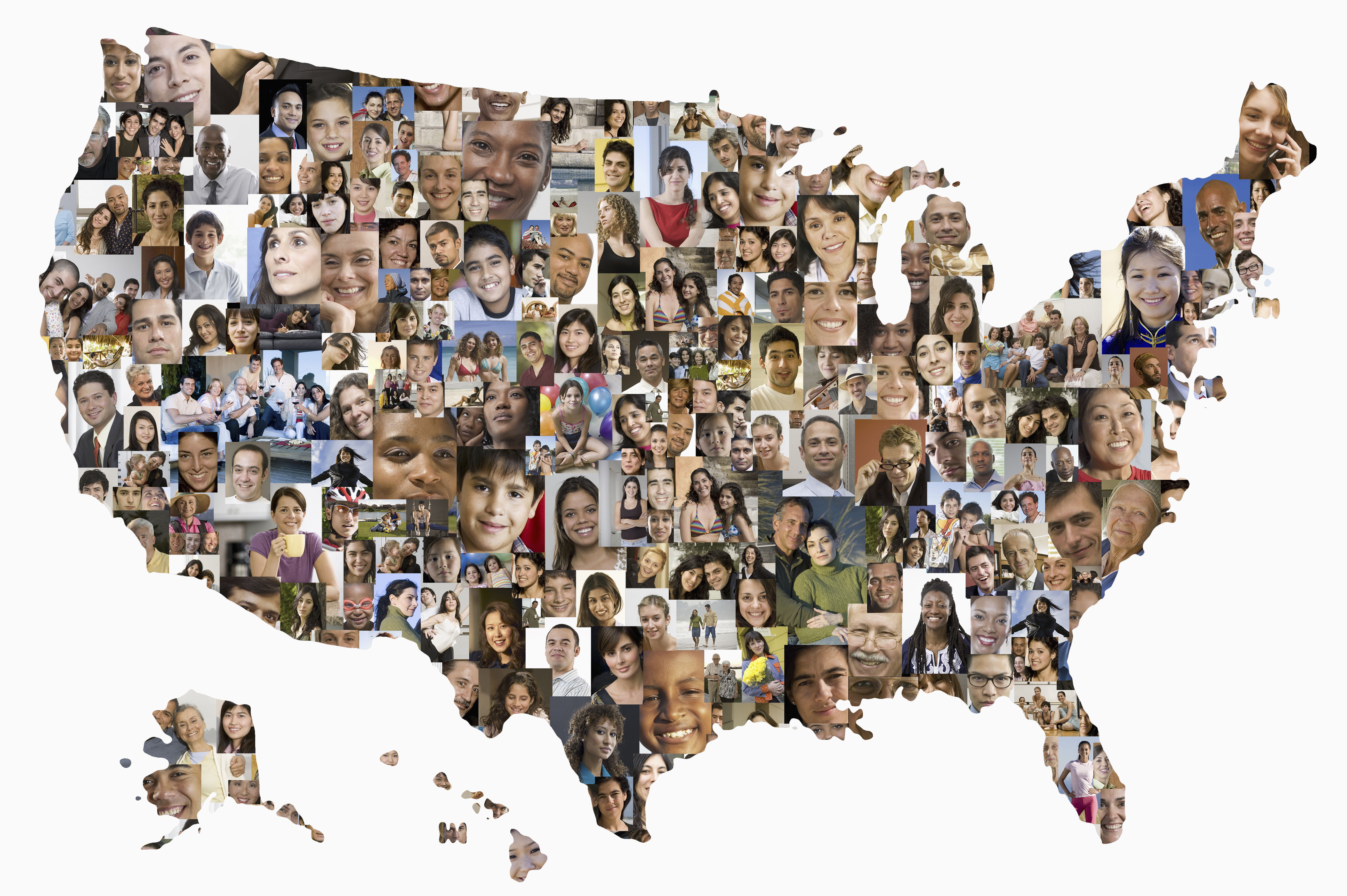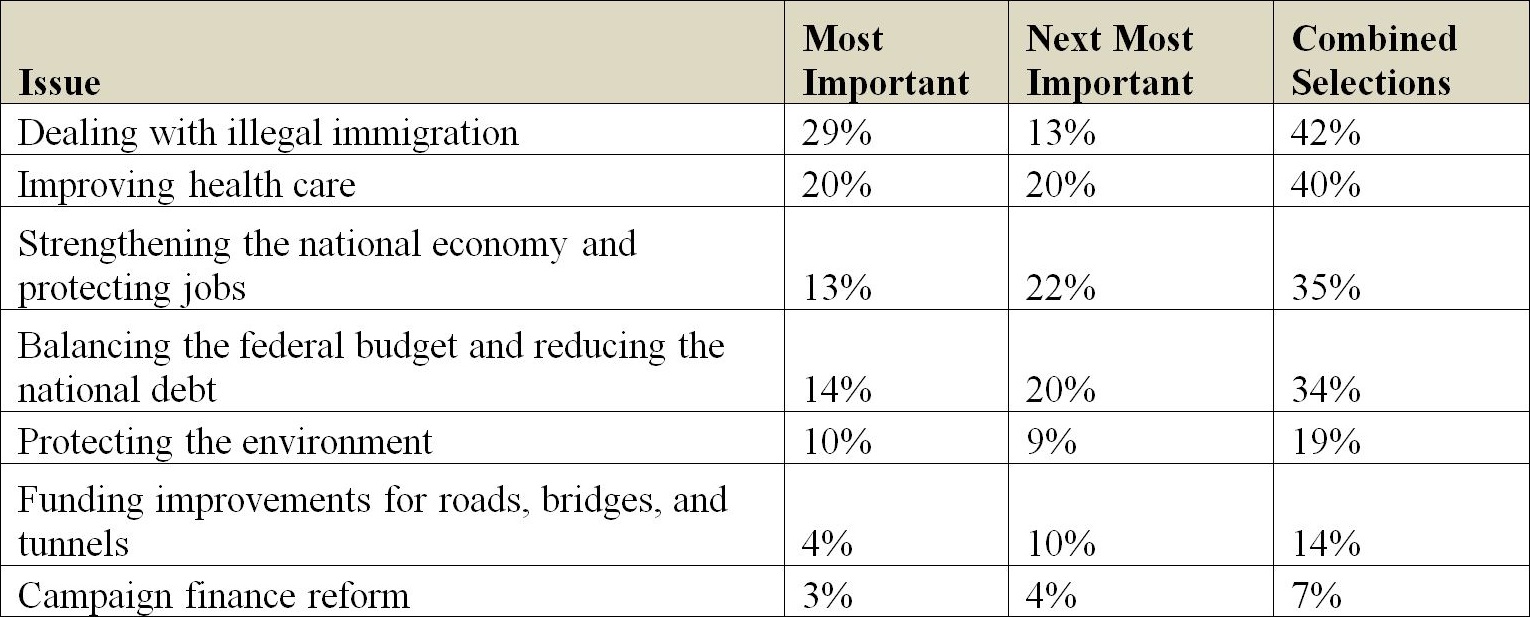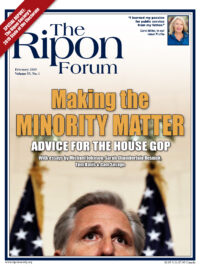
This year begins with a challenging political environment for conservatives. A majority of voters think the country is on the wrong track, and a majority of voters disapprove of the job performance of the President. In addition, the issues on which voters most want action – immigration, health care, the economy/jobs, and the budget/debt – are the issues which have gridlocked Congress for the past two years. Indeed, policy disagreements over the top concern of immigration are a prime driver of the recent government shutdown. A plurality of voters blames President Trump for the shutdown.
Despite the challenges of the current political environment, most voters continue to agree with the premise for conservative governance. A majority of voters continue to believe that the federal government is part of the problem. However, a majority of voters also continue to think that the federal government is not doing enough to solve the problems facing the country. There is real frustration among voters about the lack of problem solving in Congress as more than eight-in-ten voters think there are not enough politicians willing to go against their political party even when that is the right thing to do.
On specific policy solutions, a majority of voters reject all three proposed methods for additional infrastructure funding.
Despite most voters thinking Obamacare has kept health care service at the same level or made it worse, the only policy solution to achieve majority support is an effort to make bipartisan improvements to Obamacare with cost being the top concern for voters. In addition, a majority of voters would like to see less involvement by the federal government in healthcare.
On immigration, the fertile ground for a deal continues to be a combination of comprehensive increased border security measures and providing legal status for illegal immigrants who were brought here as minors. Most voters agree with the premise that immigration has made the country stronger.
This will be a challenging year for President Trump. Voters want to see a change in the direction of the country, but most voters are not ready to trust the President to provide solutions to get the country back on track.
On trade, the plurality of voters thinks the trade dispute with China will have a negative impact on their personal finances. On international relations, most voters want America to continue to work closely with our allies.
On privacy, more than one-third of the electorate is extremely concerned about the security of their private information though voters divide evenly on whether they want the federal government or private companies to take the lead on protecting private data.
Political Environment
Voters are frustrated with the current political environment. A strong majority of voters (62%) believe that the country is on the wrong track, including a majority of voters (54%) who strongly believe this. In contrast, under one-third (31%) of voters think the country is headed in the right direction. Majorities of Democrats (89%), Independents (72%), and even 29% of Republicans and 24% of Trump voters think the country is on the wrong track. Despite these negative sentiments, direction of the country has been upside down for close to a decade and has been as high as 64% on the Real Clear Politics average as recently as September 2017.
This frustration with the direction of the country is also seen on the job approval rating for President Trump. A majority of voters (55%) disapprove of the job performance of the President, including 48% of voters who strongly disapprove. In contrast, 42% of voters approve of his job performance.
Like the direction of the country, majorities of Independents (69%) and Democrats (93%) disapprove of his job performance though just 9% of Republicans disapprove. However, the President does have a majority disapproval rating among key voting blocs like suburban voters (59%), 2016 swing state voters (59%), seniors (55%), Hispanics (58%), those with some college education (52%), and female non-college graduates (57%). In addition, the President is upside down with one of his strongest 2016 supporters, White voters (49% disapprove).
The shutdown has caused a movement in the President’s job approval rating so that voters who were frustrated with his personal behavior but accepting of his job performance have turned negative on his job performance. However, despite this decline, the President has held his strong approval rating steady. Courting and holding the support of these strong supporters is a key goal for the Trump White House.
Both of these measures indicate this will be a challenging year for President Trump. Voters want to see a change in the direction of the country, but most voters are not ready to trust the President to provide solutions to get the country back on track. The President will need to work with Congress, particularly the House of Representatives, whose leaders have limited incentive to cooperate with him. This political challenge will make finding policy solutions very challenging.
As seen below, the top issues that voters want Congress and President to work on are immigration, health care, the economy/jobs, and the federal budget/debt.

(To view additional presentation slides from The Ripon Society’s 2019 State of the Electorate, please click here.)
There is a stark political divide on prioritizing these issues. A majority of Republicans (58%) select illegal immigration as their top issue. For health care, more than three-in-ten Democrats (31%) select this as their top issue. Independents divide on their top issue of concern with health care (21%), the federal budget/debt (19%), economy/jobs (16%), and immigration (16%) all being selected at a notable rate.
This issue matrix is also a troubling sign for getting things done in Congress this year. Republicans want action on immigration. Democrats want action on health care, and Independents want action on a variety of issues. This presents a real challenge for setting legislative priorities for action.
Regarding the current government shutdown, a plurality of voters (48%) hold President Trump most responsible for this shutdown while another 38% of voters hold the Democrats in Congress most responsible. As you would expect, blame is filtered through a partisan lens with 82% of Republicans and 84% of Trump voters thinking the Democrats in Congress are most responsible. In contrast, 85% of Democrats hold President Trump most responsible. However, a majority of Independents (55%) blame President Trump for the shutdown.
This data reinforces the challenge of finding a solution for this shutdown. The shutdown has not hurt the President’s standing with core Republican voters, and these voters continue to be willing to blame the Democrats in Congress for the shutdown. A compromise that ends the shutdown is likely to meet with derision by many of these base GOP voters. On the other side, the Democrats have successfully made the case to both their voters and to Independents that the shutdown is the fault of President Trump. Continuing to make the President look to be unable to solve this issue is helping them politically. When both sides think they are benefiting from the status quo, making a change is politically challenging.
Philosophical questions on the federal government
A strong majority (65%) of voters think the federal government is part of the problem for the challenges facing their families. This is in line with the findings from 2015 and 2017 on this question. Even majorities of seniors (65%), African Americans (67%), Hispanics (59%), Democrats (59%), and liberals (58%) select that government is part of the problem.
However, three-in-four voters (75%) think the government is not doing enough to solve the problems facing the country. This represents a 9-point growth in those selecting not enough since the 2017 survey. Even a majority of conservative Republicans (66%) think the government is not doing enough to solve the country’s problems.
However, three-in-four voters (75%) think the government is not doing enough to solve the problems facing the country. This represents a 9-point growth in those selecting not enough since the 2017 survey.
These views lead to frustration with elected officials. More than eight-in-ten voters (81%) think that there are not enough politicians in Washington willing to go against their political party when they think it is the right thing to do. This includes 66% of the likely electorate who strongly believes this.
So, most voters think the government is part of the problem while also believing that the government is not doing enough to solve problems as well as believing that there are too many politicians committed to their political party instead of to finding solutions. Leaders in Washington are facing a frustrated and skeptical electorate as they try to govern.
Infrastructure
After explaining the need for improvements to infrastructure, three proposals on infrastructure funding were tested. Responses are summarized in the chart below.

As seen above, all of these proposals face majority opposition with the electorate. Finding more federal funding for infrastructure will require other funding mechanisms or a substantial amount of voter persuasion.
Obamacare/health care reform
Asked for their views of the health care system since Obamacare took effect, a plurality (40%) of voters think the health care system has gotten worse. Among other voters, 31% think health care has gotten better, and 26% think health care has stayed about the same.
A majority (67%) of low-income voters think health care has gotten worse (34%) or stayed the same (33%). These are the voters who should have seen the most benefits from Obamacare.
Along similar lines, a majority (52%) of voters working for small businesses think health care has gotten worse. These are the voters most likely to have had bad outcomes from Obamacare.
This situation – beneficiaries being ambivalent to negative on the law’s impact and many others thinking the law has made things worse – should provide an opening for making reforms to the Obamacare law.
Four possible reforms of Obamacare were tested. Responses are summarized below.

As seen above, making bipartisan improvements is the only proposal with majority support. Both parties in Congress would do well to find ways to work together to improve Obamacare if they want to reform this law. However, even this modest and vague proposal has strong majority opposition among Republicans (69%). Any efforts at reform will need to also include significant outreach to Republican voters on the merits of this reform.
In addition, it should be noted that Medicare for All is opposed by a majority (53%) of seniors. Most seniors are not interested in expanding Medicare to include citizens from other age ranges.
Voters are also given five possible areas for improvement via health care reform and asked to select the most important and next most important area for improvement. Responses are summarized in the chart below.

As seen above, both of the most selected areas deal with cost – reducing the cost of health insurance and making prescription drugs more affordable. Reforming health care in ways that lower costs for consumers will be reforms that respond to the concerns of significant portions of the electorate.
In fact, a majority (57%) of voters say they would prefer less involvement from the government in health care, including 47% of voters who would strongly prefer this. Having less involvement is the preference of majorities of Republicans (83%) and Independents (54%) and 34% of Democrats. Health care reforms in which the government uses regulations to lower costs without having an outsized role in the health care insurance market would please a strong majority of the electorate.
Obamacare/health care reform
Voters were presented with three (3) proposals on immigration. Responses are summarized below.

As seen above, a deal on immigration reform that incorporated increased border security with providing legal status for Dreamers would have the support of the majority of the electorate.
Building the wall has turned into a politically divisive issue. Fully 88% of Republicans and 93% of partisan Republicans support building the wall while strong majorities of both Independents (68%) and Democrats (92%) oppose building it.
Despite these differences, there is broad agreement (66%) among voters that immigration has made the United States stronger. Even 45% of partisan Republicans agree with this assertion.
Trade/International Relations
Voters were read a brief description of the trade dispute with China, including the use of tariffs by both countries. Voters were then asked to gauge the impact of these tariffs on their personal economic situation. Forty-two percent (42%) of voters believe this trade dispute is going to have a negative impact on their personal finances. However, a majority of voters (53%) think this trade dispute will have no impact (36%) or a positive impact (17%) on their personal finances.
These views are driven by partisanship. Majorities of Independents (52%) and Democrats (61%) think this trade dispute will have a negative impact on their finances while just 18% of Republicans share this view. This trade dispute is a political issue and not yet an economic one.
Voters were read the two statements below on international relations and asked to select the one that most closely matched their own views.
- America is best when it acts alone on economic and defense issues, is not bound by international agreements, and puts the wellbeing of its own citizens above the rest of the world; or,
- America is best when it works closely with our allies to increase global prosperity and defend freedom against global threats.
Two-in-three voters (67%) select the second option about working closely with allies. Even 44% of Trump voters select this option. Despite the rhetoric of the President and others in the Republican party, most voters still want America to be engaged with its allies.
Privacy
Fully 34% of voters say they are extremely concerned about the security of their private information. There is a high level of concern about privacy among a diverse subsection of voters that includes 45-64 year olds (40%), African-Americans (45%), Hispanics (43%), very conservative voters (41%), and those who work in public service (41%). This diversity indicates that taking an active stand on data privacy is an effective way for legislators to reach out to voters that normally are not open to persuasion about their votes.
Regarding the federal government and data privacy, voters split relatively equally – 44% of voters want the federal government to take the lead on ensuring the protection of personal privacy while 44% of voters prefer for private companies to take the lead on this issue.
As you would expect, there is a strong partisan divide on this issue. A majority of Republicans (58%) want private companies to take the lead while a majority of Democrats (54%) and a plurality of Independents (46%) want the federal government to take the lead. Even this personal issue remains driven by partisanship.
Conclusions
In what looks to be a challenging year for conservatives with a political environment trending against them, there are fruitful areas for conservative advocacy. Voters agree that the federal government is part of the problem and want politicians willing to take bold actions.
There is support among voters for a policy solution on immigration that combines enhanced border security with providing legal status for dreamers. In addition, while voters are not feeling the immediate economic impact of the trade disputes with China, most voters still prefer for the United States to remain engaged in the world.
Lastly, many voters are concerned about data privacy, and creating a public-private partnership to better protect data would find favor with many voters.
Ed Goeas is President & CEO and Brian Nienaber is a Vice President at The Tarrance Group, one of the most respected and successful Republican research and strategy firms in American politics today.
__________________________________
Methodology
The Tarrance Group is pleased to present these key findings from a national survey of likely voters nationwide. All respondents interviewed in this study were part of a fully representative sample of N=800 registered likely voters. Responses to this survey were gathered January 14-17, 2019. The confidence interval associated with a sample of this type is ±3.5% in 19 of 20 cases.




